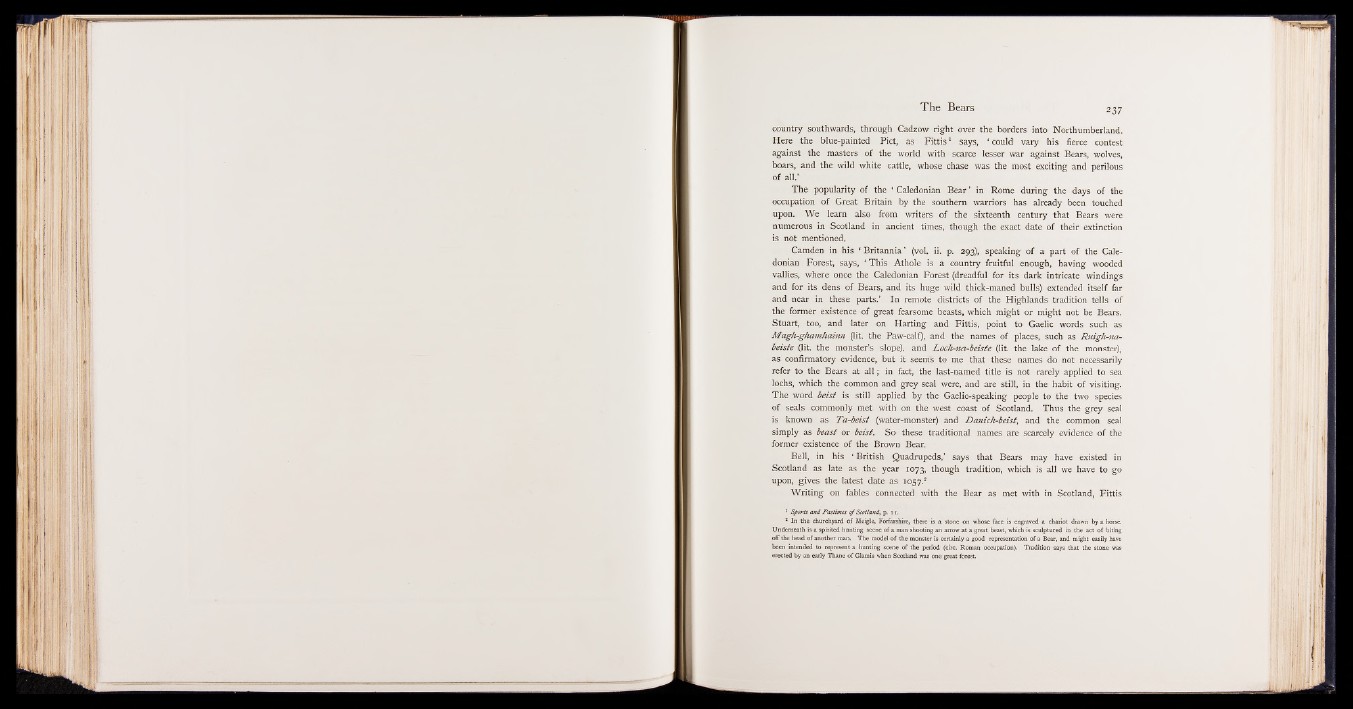
country southwards, through Cadzow right over the borders into Northumberland.
Here the blue-painted Piet, as Fittis1 says, ‘ could vary his fierce contest
against the masters of the world with scarce lesser war against Bears, wolves,
boars, and the wild white cattle, whose chase was the most exciting and perilous
of all.’
The popularity of the * Caledonian Bear ’ in Rome during the days of the
occupation of Great Britain by the southern warriors has already been touched
upon. We learn also from writers of the sixteenth century that Bears were
numerous in Scotland in ancient times, though the exact date of their extinction
is not mentioned.
Camden in his * Britannia ’ (vol. ii. p. 293), speaking of a part of the Caledonian
Forest, says, ‘ This Athole is a country fruitful enough, having wooded
vallies, where once the Caledonian Forest (dreadful for its dark intricate windings
and for its dens of Bears, and its huge wild thick-maned bulls) extended itself far
and near in these parts.’ In remote districts of the Highlands tradition tells of
the former existence of great fearsome beasts, which might or might not be Bears.
Stuart, too, and later on Halting and Fittis, point to Gaelic words such as
Magh-ghamhainn (lit. the Paw-calf), and the names of places, such as Ruigh-na-
beisie (lit. the monster’s slope), and Loch-na-beiste (lit. the lake of the monster),
as confirmatory evidence, but it seenft to me that these names do not necessarily
refer to the Bears at a l l; in fact, the last-named title is not rarely applied to sea
lochs, which the common and grey seal were, and are still, in the habit of visiting.
The word beist is still applied by the Gaelic-speaking people to the two species
of seals commonly met with on the west coast of Scotland. Thus the grey seal
is known as Ta-beist (water-monster) and Danich-beist, and the common seal
simply as beast or beist. So these traditional names are scarcely evidence of the
former existence of the Brown Bear.
Bell, in his ‘ British Quadrupeds,’ says that Bears may have existed in
Scotland as late as the year 1073, though tradition, which is all we have to go
upon, gives the latest date as 1057.2
Writing on fables connected with the Bear as met with in Scotland, Fittis
1 Sports and Pastimes o f Scotland, p. n .
* In the churchyard of Meigle, Forfarshire, there is a stone on whose face is engraved a chariot drawn by a horse.
Underneath is a spirited hunting scene of a man shooting an arrow at a great beast, which is sculptured in the act of biting
off the head of another man. The model of the monster is certainly a good representation of a Bear, and might easily have
been intended to represent a hunting scene of the period (circ. Roman occupation). Tradition says that the stone was
erected by an early Thane o f Glamis when Scotland was one great forest.